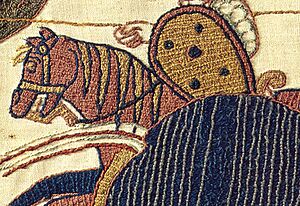Bayeux Tapestry facts for kids
The Bayeux Tapestry is a very long embroidered cloth. It's not a true tapestry, which is woven. This amazing artwork shows the story of the Norman conquest of England. It covers the events leading up to the invasion and the invasion itself. The tapestry has notes written in Latin. You can see it today in a special museum in Bayeux, Normandy, France. This museum is called the Musée de la Tapisserie de Bayeux.
The tapestry tells the exciting story of the Norman conquest of England in 1066. The two main groups fighting were the Anglo-Saxon English and the Normans. The English were led by Harold Godwinson, who had just become the King of England. The Normans were led by William the Conqueror.
People consider the Bayeux Tapestry one of the greatest examples of Anglo-Saxon art. Even though a Norman ordered it, English (Anglo-Saxon) artists made it. It is also a very important historical document. It helps us understand what happened during that time.
What is the Bayeux Tapestry?
The Bayeux Tapestry is often called a "tapestry." However, it is actually an embroidery. This means the pictures are stitched onto a piece of cloth. A true tapestry has its design woven directly into the fabric. This artwork is similar to other embroidered hangings from the early medieval period.
How it was Made
The Bayeux Tapestry is made from wool yarn stitched onto a linen cloth. The linen fabric is made of several pieces sewn together. It has also been repaired in many places over time.
The artists used two main ways of stitching:
- Outline or stem stitch: This was used for the letters and the outlines of the figures.
- Couching or laid work: This method filled in the figures with color.
The main colors of the wool yarn are reddish-brown, blue-green, dull gold, and olive green. There are also small amounts of dark blue or black and sage green.
Images for kids
-
A scene from the Bayeux Tapestry showing Bishop Odo encouraging Duke William's soldiers during the Battle of Hastings in 1066.
-
Bishop Odo of Bayeux.
-
A drawing by Montfaucon / Benoît showing King Harold's death.
-
The messengers with Guy I, Count of Ponthieu, with a picture of medieval farming in the border.
-
A close-up of Halley's Comet shown in the tapestry.
-
A scene from the Battle of Hastings.
-
The Coronation of Harold, seemingly by Stigand.
-
The start of the Bayeux Tapestry replica in Reading Museum.
See also
 In Spanish: Tapiz de Bayeux para niños
In Spanish: Tapiz de Bayeux para niños
















